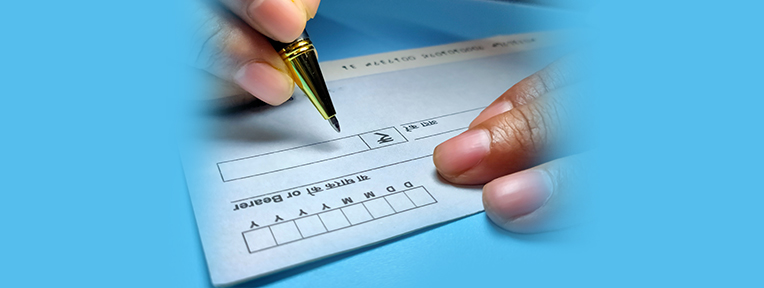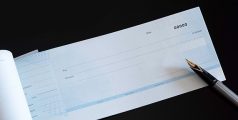
How to Fill a Cheque Correctly: A Simple Step-by-Step Guide
Posted on Tuesday, May 27th, 2025 | By IndusInd Bank
With the rise of UPI and internet banking, you might think cheques are a thing of the past. But guess what? They’re still widely used across India—especially for rent payments, insurance premiums, school fees, and formal business transactions.
If you’ve ever found yourself staring at a blank cheque wondering where to begin, you’re not alone. In this guide, we’ll walk you through how to fill a cheque, how to use your cheque book, and even how to complete a cheque deposit slip. Let’s make you cheque-savvy in just a few minutes.
Parts of a Cheque You Need to Fill Out
Let’s break it down. Every cheque has a few essential sections you need to complete. Here’s what they are:
| S. No. | Part | Description |
| 1 | Date | Write the date in the format DD/MM/YYYY. This tells the bank when the cheque becomes valid. |
| 2 | Payee’s Name | Write the name of the person or organisation you’re paying. Avoid nicknames or short forms. |
| 3 | Amount in Words | Always start from the extreme left to prevent tampering. E.g., “Rupees One Thousand Only”. |
| 4 | Amount in Numbers | Write the amount in the box provided, like this: 1,000.00 |
| 5 | Your Signature | Sign exactly as per your bank records. No signature = invalid cheque. |
| 6 | Account Number (in multi-account cheques) | Some banks issue cheques with multiple account options—tick the right one if applicable. |
Also Read: What Is a Cheque Deposit Slip?
How to Write a Cheque Step-by-Step
Now that you know the parts, here’s a step-by-step guide on how to write a cheque correctly:
Step #1: Write the correct date on the top right corner.
Step #2: Mention the payee’s full name without any spelling errors.
Step #3: Write the amount in words, making sure to add “only” at the end.
Step #4: Fill in the amount in numbers inside the box provided.
Step #5: Sign the cheque as per your official bank signature.
Step #6: Strike through any unused space after the amount to prevent fraud.
Don’t:
- Leave any fields blank
- Use a pencil or erasable ink
- Sign before filling in other details
Types of Cheques in India You Should Know
Cheques come in different forms, each designed for specific situations. Knowing the difference can help you use the right one and avoid confusion.
| S. No. | Type of Cheque | Description |
| 1 | Bearer Cheque | Can be encashed by whoever presents it at the bank. Risky if misplaced, as anyone can claim the money. |
| 2 | Order Cheque | Issued in the name of a specific person. The bank will release payment only to that individual (or someone authorised). |
| 3 | Crossed Cheque | Two parallel lines on the top left corner make it a “crossed” cheque. It can’t be encashed directly and must be deposited into a bank account—making it more secure. |
| 4 | Post Dated Cheque | Dated for a future date. The bank will only process it on or after that date, commonly used for scheduled payments like EMIs or rent. |
| 5 | Stale Cheque | A cheque is considered stale if it is presented after three months from the date mentioned on it. Banks will usually reject it. |
| 6 | Open Cheque | A cheque that is neither crossed nor marked “account payee”. It can be encashed at the counter or deposited into an account—useful, but less secure. |
| 7 | Traveller’s Cheque | Prepaid cheques used for carrying foreign currency while travelling abroad. These are now largely replaced by forex cards. |
| 8 | Self Cheque | A cheque where the word “Self” is written in the payee section. You can use it to withdraw cash from your own account at the bank. |
| 9 | Banker’s Cheque | Issued by a bank on behalf of a customer to guarantee payment to a third party. Often used for making high-value payments like property deals or government tenders. |
Also Read: How to Get a New Chequebook?
Tips for Writing a Cheque Safely
Writing a cheque may seem simple, but one careless mistake could lead to delays, fraud, or even legal issues. Here are some tried-and-tested tips to help you write a cheque securely and confidently:
1. Use a Permanent Blue or Black Ink Pen
Avoid fancy gel pens, pencils, or erasable inks. Use a permanent ink pen that leaves no room for tampering. Blue ink is often preferred as it distinguishes the original from photocopies.
2. Start Writing from the Extreme Left
Whether you’re writing the payee’s name or the amount in words, always begin from the extreme left side of the respective line. This prevents anyone from inserting additional text.
3. Strike Through Unused Spaces
If there’s space left after writing the amount or the name, draw a line through the empty area. For example, write “Rupees One Thousand Only” and strike through the rest of the line.
4. Double-Check the Date
An incorrect or missing date can make the cheque invalid. Also, avoid post-dating a cheque unless you intend it for future use. If the date is too old (over 3 months), it becomes stale.
5. Avoid Overwriting or Corrections
Cheques with overwriting, whitener marks, or correction fluid are often rejected by banks. If you make a mistake, it’s better to cancel the cheque and write a new one.
6. Keep Your Signature Consistent
Your cheque will be invalid if the signature doesn’t match your bank records. Always sign using your registered signature and avoid stylising it differently.
7. Write “A/C Payee” Between Two Parallel Lines
To ensure that the cheque can only be deposited into the named payee’s bank account, draw two parallel lines on the top left and write “A/C Payee” between them. This adds an extra layer of security.
8. Fill Out the Cheque Stub or Counterfoil
Most cheque books have a stub or counterfoil next to each cheque leaf. Record the cheque number, amount, date, and payee name for your own tracking and reference.
9. Don’t Sign a Blank Cheque
Never sign a cheque and leave the other fields blank. It’s one of the most common causes of cheque misuse and fraud.
10. Store Your Cheque Book Securely
Treat your cheque book like you would cash or your ATM card. Keep it in a safe place and never leave it unattended, especially in public or shared spaces.
11. Check Your Account Balance Before Issuing a Cheque
Issuing a cheque without having sufficient funds in your account can result in a cheque bounce, which may lead to penalties and even legal trouble under Section 138 of the Negotiable Instruments Act.
Wrapping Up!
So, there you have it—a complete, easy-to-follow guide on how to fill a cheque, your cheque book, and a cheque deposit slip.
Even if you don’t write cheques every day, it’s still an essential banking skill to have. The key is to stay neat, accurate, and cautious. One tiny mistake on a cheque can delay your payment—or worse, cause it to bounce. Now that you’re armed with this knowledge, you’ll never second-guess yourself at the cheque table again.



 Offers
Offers Rates
Rates Debit Card Related
Debit Card Related Credit Card Related
Credit Card Related Manage Mandate(s)
Manage Mandate(s) Get Mini Statement
Get Mini Statement
 categories
categories Bloggers
Bloggers Blog collection
Blog collection Press Release
Press Release


